Organisational Behaviour Assignment : TESCO PLC
VerifiedAdded on 2021/02/19
|16
|5302
|48
AI Summary
Contribute Materials
Your contribution can guide someone’s learning journey. Share your
documents today.
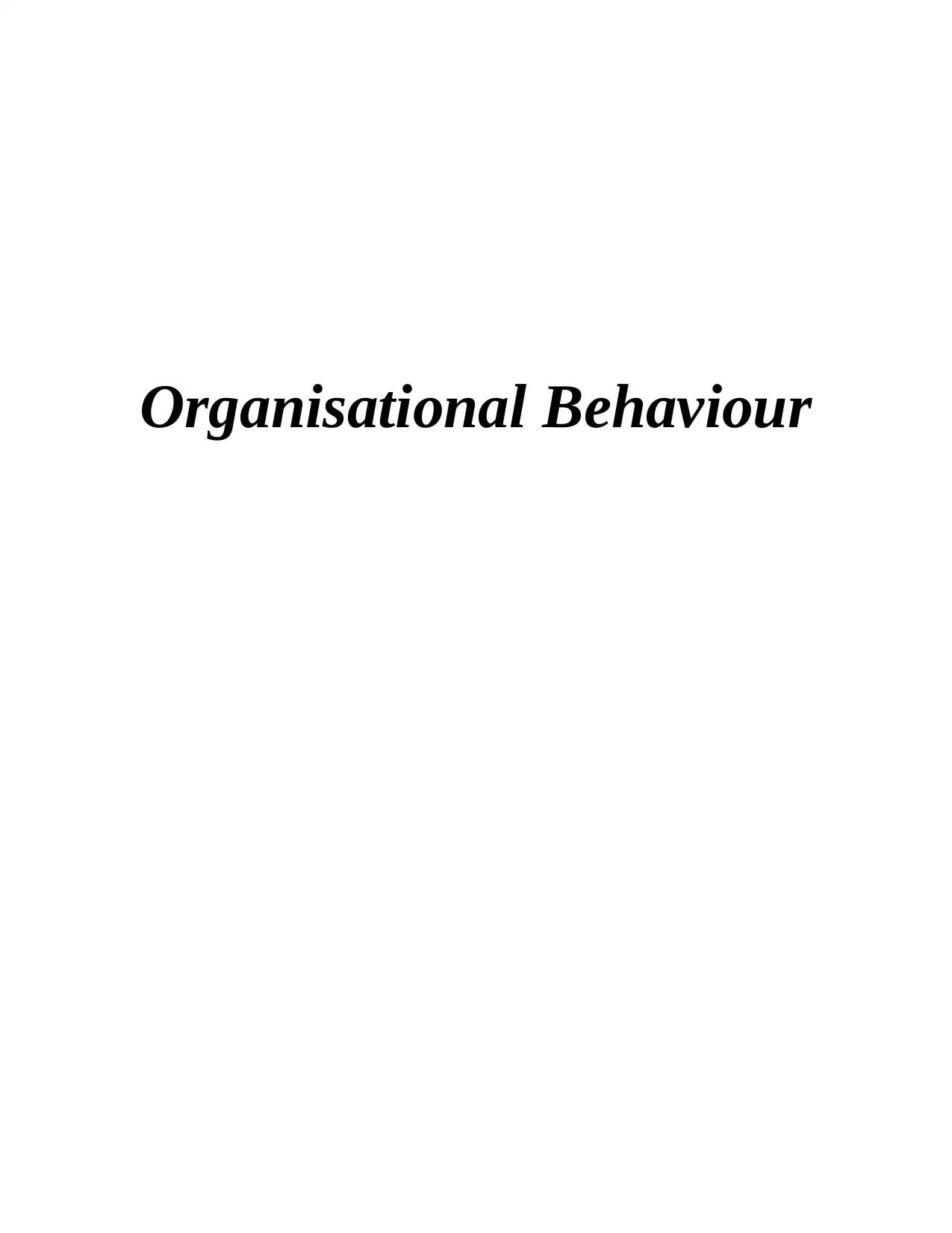
Organisational Behaviour
Secure Best Marks with AI Grader
Need help grading? Try our AI Grader for instant feedback on your assignments.
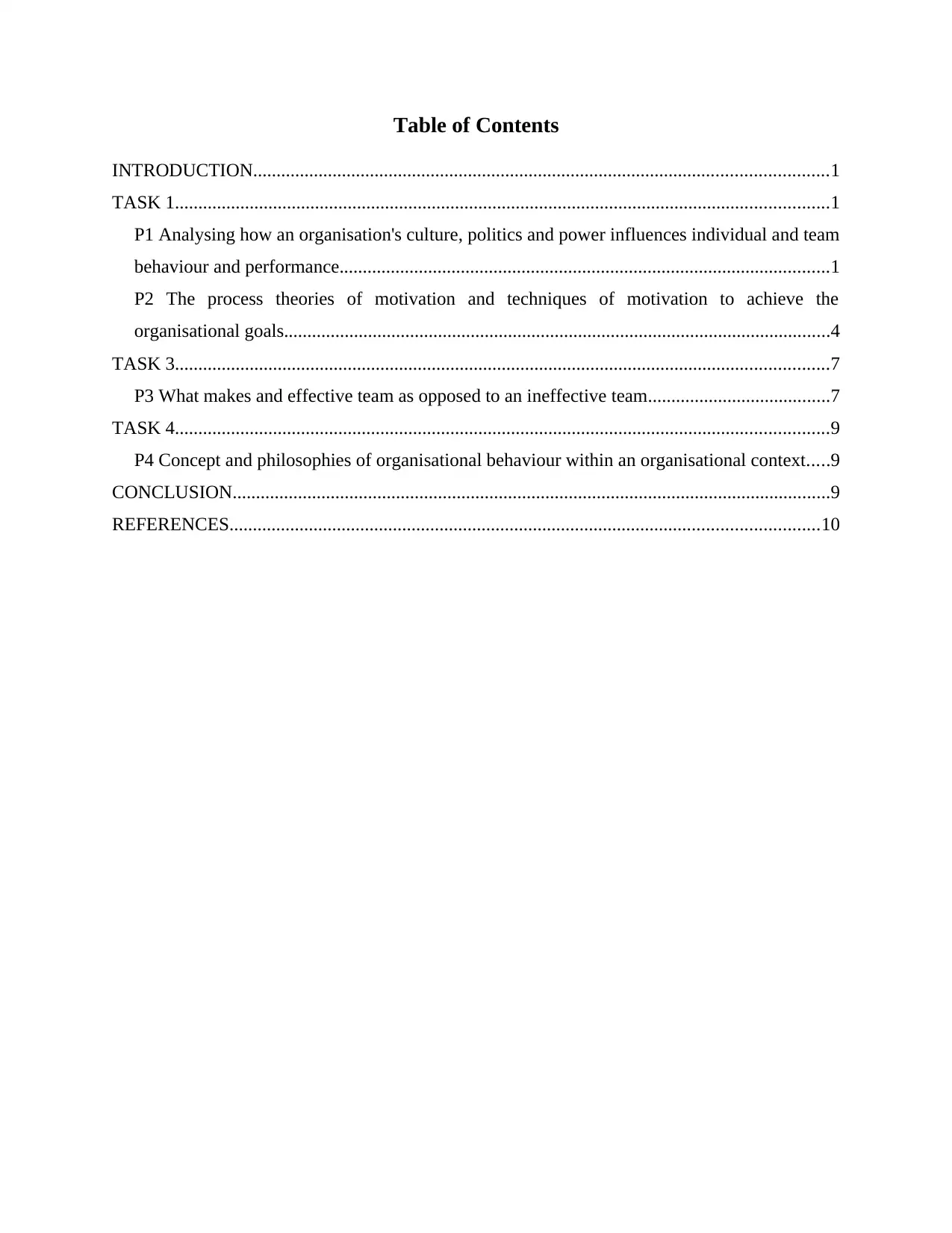
Table of Contents
INTRODUCTION...........................................................................................................................1
TASK 1............................................................................................................................................1
P1 Analysing how an organisation's culture, politics and power influences individual and team
behaviour and performance.........................................................................................................1
P2 The process theories of motivation and techniques of motivation to achieve the
organisational goals.....................................................................................................................4
TASK 3............................................................................................................................................7
P3 What makes and effective team as opposed to an ineffective team.......................................7
TASK 4............................................................................................................................................9
P4 Concept and philosophies of organisational behaviour within an organisational context.....9
CONCLUSION................................................................................................................................9
REFERENCES..............................................................................................................................10
INTRODUCTION...........................................................................................................................1
TASK 1............................................................................................................................................1
P1 Analysing how an organisation's culture, politics and power influences individual and team
behaviour and performance.........................................................................................................1
P2 The process theories of motivation and techniques of motivation to achieve the
organisational goals.....................................................................................................................4
TASK 3............................................................................................................................................7
P3 What makes and effective team as opposed to an ineffective team.......................................7
TASK 4............................................................................................................................................9
P4 Concept and philosophies of organisational behaviour within an organisational context.....9
CONCLUSION................................................................................................................................9
REFERENCES..............................................................................................................................10

INTRODUCTION
Organisational behaviour is defined as the study and application of knowledge that how
any of the individual is required to act within the premisses of an organisation. It is necessary
because it helps to understand about the complex nature of an individual by trying to find the
main causes and effect of their behaviour (Afsar and Badir, 2016). In this project, the chosen
organisation is TESCO PLC. It is a British multinational groceries and general merchandise
retailer. The header of the company is located in Welwyn Garden City, Hertfordshire, England.
In context of the file,their will be the discussion on various organisational cultures and
motivational theories. Also, there will be the evaluation on theories which have been discussed.
In second part, teamwork theories and their effectiveness will be discussed.
TASK 1
P1 Analysing how an organisation's culture, politics and power influences individual and team
behaviour and performance.
Organisation behaviour is one of the most topic which do play important role within the
organisation. In context of TESCO Plc, they can take the help of Handy's culture typology and
Hofestede's cultural dimension to know the behaviour of an individual and team
Handy's culture Dimensions Power culture: It is the culture of organisation in which only limited number of person
do get the rights and responsibilities to take any of the decision. Here, employee's of
TESCO Plc is required to follow the instruction supreme authority through which
performance of individual and teams can be enhanced.
Role culture: In this culture, the manager of a company have to play crucial role for
improving the performance of organisation. In context of TESCO Plc, their manager is
required to distribute the role and responsibility as per the ability of existing employee's.
This will also help to improve the performance of individual and team which have been
divided with in the company.
Task culture: The main focus of task culture is to accomplish the goals and targets on
specific period of time (Hart, Gilstrap and Bolino, 2016). TESCO can be benefited with
this culture as they will be able to obtain the result on particular time period. In this,
1
Organisational behaviour is defined as the study and application of knowledge that how
any of the individual is required to act within the premisses of an organisation. It is necessary
because it helps to understand about the complex nature of an individual by trying to find the
main causes and effect of their behaviour (Afsar and Badir, 2016). In this project, the chosen
organisation is TESCO PLC. It is a British multinational groceries and general merchandise
retailer. The header of the company is located in Welwyn Garden City, Hertfordshire, England.
In context of the file,their will be the discussion on various organisational cultures and
motivational theories. Also, there will be the evaluation on theories which have been discussed.
In second part, teamwork theories and their effectiveness will be discussed.
TASK 1
P1 Analysing how an organisation's culture, politics and power influences individual and team
behaviour and performance.
Organisation behaviour is one of the most topic which do play important role within the
organisation. In context of TESCO Plc, they can take the help of Handy's culture typology and
Hofestede's cultural dimension to know the behaviour of an individual and team
Handy's culture Dimensions Power culture: It is the culture of organisation in which only limited number of person
do get the rights and responsibilities to take any of the decision. Here, employee's of
TESCO Plc is required to follow the instruction supreme authority through which
performance of individual and teams can be enhanced.
Role culture: In this culture, the manager of a company have to play crucial role for
improving the performance of organisation. In context of TESCO Plc, their manager is
required to distribute the role and responsibility as per the ability of existing employee's.
This will also help to improve the performance of individual and team which have been
divided with in the company.
Task culture: The main focus of task culture is to accomplish the goals and targets on
specific period of time (Hart, Gilstrap and Bolino, 2016). TESCO can be benefited with
this culture as they will be able to obtain the result on particular time period. In this,
1
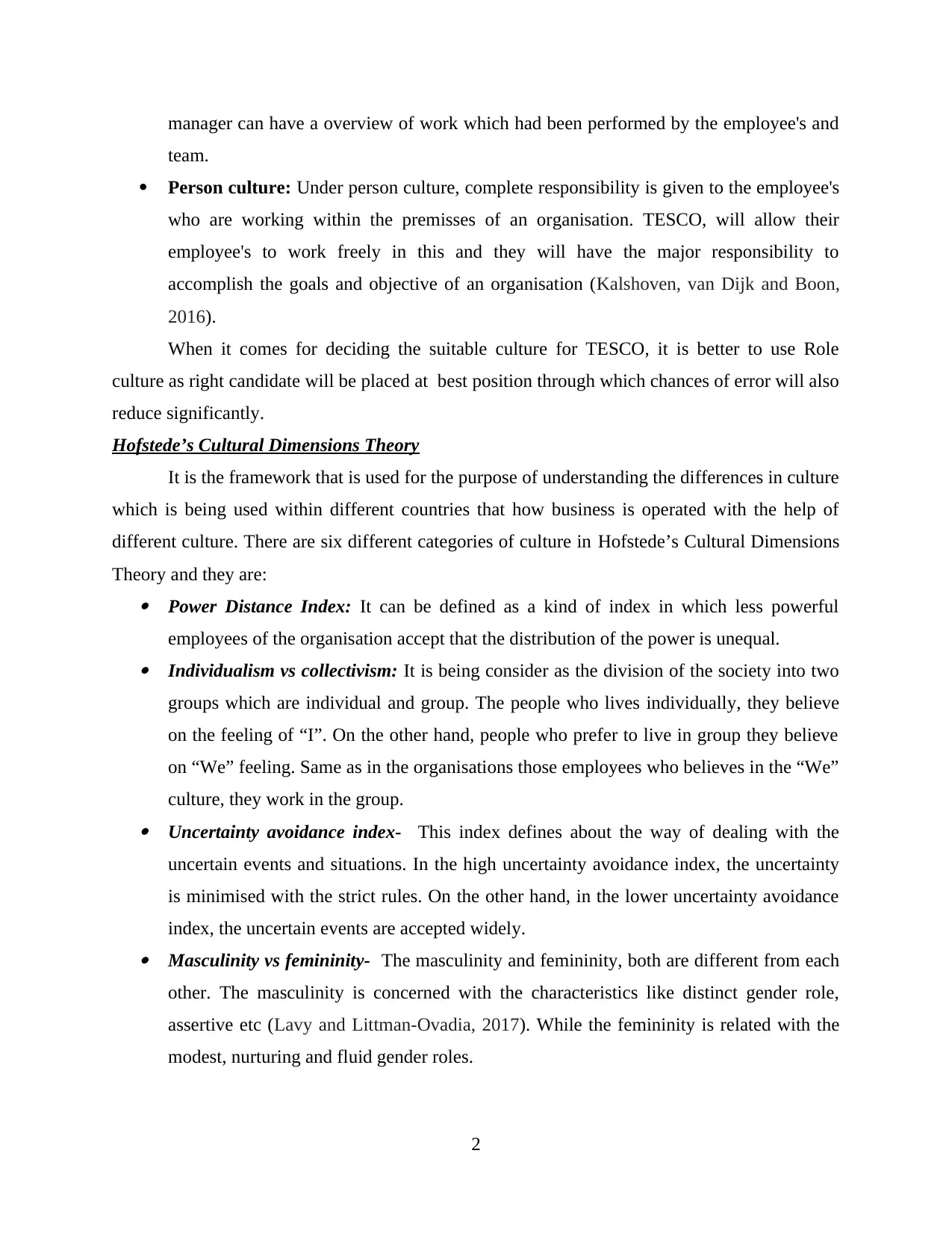
manager can have a overview of work which had been performed by the employee's and
team.
Person culture: Under person culture, complete responsibility is given to the employee's
who are working within the premisses of an organisation. TESCO, will allow their
employee's to work freely in this and they will have the major responsibility to
accomplish the goals and objective of an organisation (Kalshoven, van Dijk and Boon,
2016).
When it comes for deciding the suitable culture for TESCO, it is better to use Role
culture as right candidate will be placed at best position through which chances of error will also
reduce significantly.
Hofstede’s Cultural Dimensions Theory
It is the framework that is used for the purpose of understanding the differences in culture
which is being used within different countries that how business is operated with the help of
different culture. There are six different categories of culture in Hofstede’s Cultural Dimensions
Theory and they are: Power Distance Index: It can be defined as a kind of index in which less powerful
employees of the organisation accept that the distribution of the power is unequal. Individualism vs collectivism: It is being consider as the division of the society into two
groups which are individual and group. The people who lives individually, they believe
on the feeling of “I”. On the other hand, people who prefer to live in group they believe
on “We” feeling. Same as in the organisations those employees who believes in the “We”
culture, they work in the group. Uncertainty avoidance index- This index defines about the way of dealing with the
uncertain events and situations. In the high uncertainty avoidance index, the uncertainty
is minimised with the strict rules. On the other hand, in the lower uncertainty avoidance
index, the uncertain events are accepted widely. Masculinity vs femininity- The masculinity and femininity, both are different from each
other. The masculinity is concerned with the characteristics like distinct gender role,
assertive etc (Lavy and Littman-Ovadia, 2017). While the femininity is related with the
modest, nurturing and fluid gender roles.
2
team.
Person culture: Under person culture, complete responsibility is given to the employee's
who are working within the premisses of an organisation. TESCO, will allow their
employee's to work freely in this and they will have the major responsibility to
accomplish the goals and objective of an organisation (Kalshoven, van Dijk and Boon,
2016).
When it comes for deciding the suitable culture for TESCO, it is better to use Role
culture as right candidate will be placed at best position through which chances of error will also
reduce significantly.
Hofstede’s Cultural Dimensions Theory
It is the framework that is used for the purpose of understanding the differences in culture
which is being used within different countries that how business is operated with the help of
different culture. There are six different categories of culture in Hofstede’s Cultural Dimensions
Theory and they are: Power Distance Index: It can be defined as a kind of index in which less powerful
employees of the organisation accept that the distribution of the power is unequal. Individualism vs collectivism: It is being consider as the division of the society into two
groups which are individual and group. The people who lives individually, they believe
on the feeling of “I”. On the other hand, people who prefer to live in group they believe
on “We” feeling. Same as in the organisations those employees who believes in the “We”
culture, they work in the group. Uncertainty avoidance index- This index defines about the way of dealing with the
uncertain events and situations. In the high uncertainty avoidance index, the uncertainty
is minimised with the strict rules. On the other hand, in the lower uncertainty avoidance
index, the uncertain events are accepted widely. Masculinity vs femininity- The masculinity and femininity, both are different from each
other. The masculinity is concerned with the characteristics like distinct gender role,
assertive etc (Lavy and Littman-Ovadia, 2017). While the femininity is related with the
modest, nurturing and fluid gender roles.
2
Secure Best Marks with AI Grader
Need help grading? Try our AI Grader for instant feedback on your assignments.
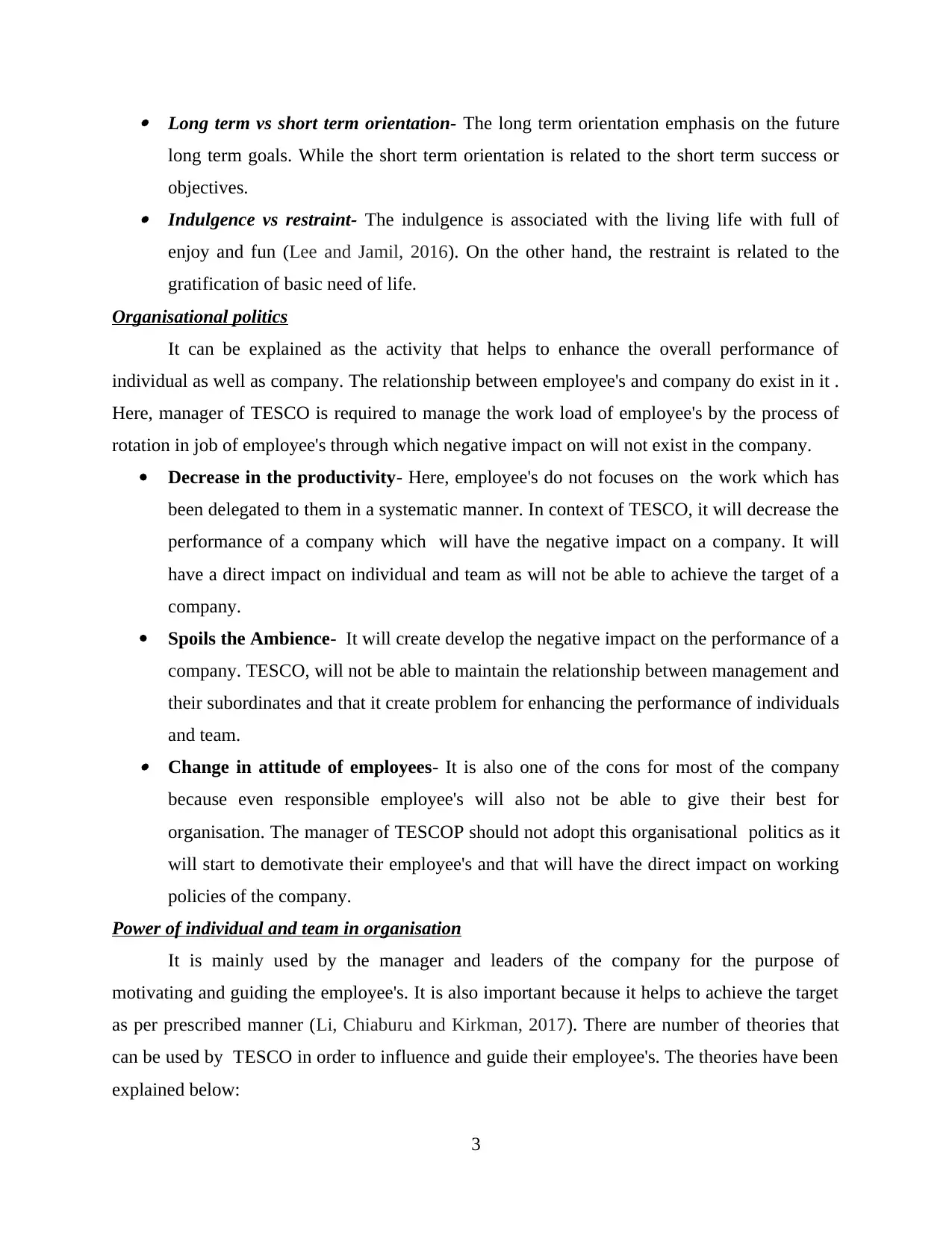
Long term vs short term orientation- The long term orientation emphasis on the future
long term goals. While the short term orientation is related to the short term success or
objectives. Indulgence vs restraint- The indulgence is associated with the living life with full of
enjoy and fun (Lee and Jamil, 2016). On the other hand, the restraint is related to the
gratification of basic need of life.
Organisational politics
It can be explained as the activity that helps to enhance the overall performance of
individual as well as company. The relationship between employee's and company do exist in it .
Here, manager of TESCO is required to manage the work load of employee's by the process of
rotation in job of employee's through which negative impact on will not exist in the company.
Decrease in the productivity- Here, employee's do not focuses on the work which has
been delegated to them in a systematic manner. In context of TESCO, it will decrease the
performance of a company which will have the negative impact on a company. It will
have a direct impact on individual and team as will not be able to achieve the target of a
company.
Spoils the Ambience- It will create develop the negative impact on the performance of a
company. TESCO, will not be able to maintain the relationship between management and
their subordinates and that it create problem for enhancing the performance of individuals
and team. Change in attitude of employees- It is also one of the cons for most of the company
because even responsible employee's will also not be able to give their best for
organisation. The manager of TESCOP should not adopt this organisational politics as it
will start to demotivate their employee's and that will have the direct impact on working
policies of the company.
Power of individual and team in organisation
It is mainly used by the manager and leaders of the company for the purpose of
motivating and guiding the employee's. It is also important because it helps to achieve the target
as per prescribed manner (Li, Chiaburu and Kirkman, 2017). There are number of theories that
can be used by TESCO in order to influence and guide their employee's. The theories have been
explained below:
3
long term goals. While the short term orientation is related to the short term success or
objectives. Indulgence vs restraint- The indulgence is associated with the living life with full of
enjoy and fun (Lee and Jamil, 2016). On the other hand, the restraint is related to the
gratification of basic need of life.
Organisational politics
It can be explained as the activity that helps to enhance the overall performance of
individual as well as company. The relationship between employee's and company do exist in it .
Here, manager of TESCO is required to manage the work load of employee's by the process of
rotation in job of employee's through which negative impact on will not exist in the company.
Decrease in the productivity- Here, employee's do not focuses on the work which has
been delegated to them in a systematic manner. In context of TESCO, it will decrease the
performance of a company which will have the negative impact on a company. It will
have a direct impact on individual and team as will not be able to achieve the target of a
company.
Spoils the Ambience- It will create develop the negative impact on the performance of a
company. TESCO, will not be able to maintain the relationship between management and
their subordinates and that it create problem for enhancing the performance of individuals
and team. Change in attitude of employees- It is also one of the cons for most of the company
because even responsible employee's will also not be able to give their best for
organisation. The manager of TESCOP should not adopt this organisational politics as it
will start to demotivate their employee's and that will have the direct impact on working
policies of the company.
Power of individual and team in organisation
It is mainly used by the manager and leaders of the company for the purpose of
motivating and guiding the employee's. It is also important because it helps to achieve the target
as per prescribed manner (Li, Chiaburu and Kirkman, 2017). There are number of theories that
can be used by TESCO in order to influence and guide their employee's. The theories have been
explained below:
3
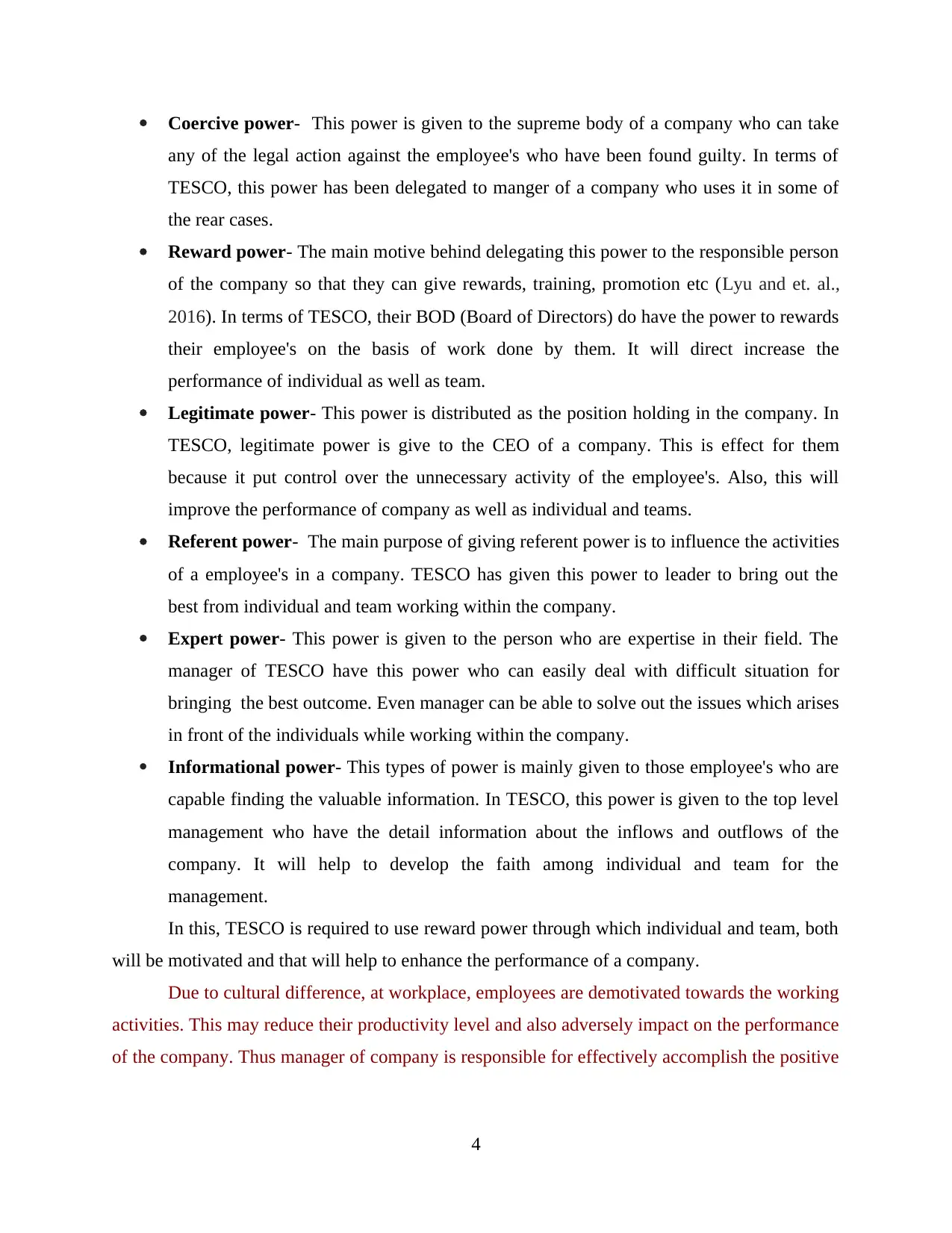
Coercive power- This power is given to the supreme body of a company who can take
any of the legal action against the employee's who have been found guilty. In terms of
TESCO, this power has been delegated to manger of a company who uses it in some of
the rear cases.
Reward power- The main motive behind delegating this power to the responsible person
of the company so that they can give rewards, training, promotion etc (Lyu and et. al.,
2016). In terms of TESCO, their BOD (Board of Directors) do have the power to rewards
their employee's on the basis of work done by them. It will direct increase the
performance of individual as well as team.
Legitimate power- This power is distributed as the position holding in the company. In
TESCO, legitimate power is give to the CEO of a company. This is effect for them
because it put control over the unnecessary activity of the employee's. Also, this will
improve the performance of company as well as individual and teams.
Referent power- The main purpose of giving referent power is to influence the activities
of a employee's in a company. TESCO has given this power to leader to bring out the
best from individual and team working within the company.
Expert power- This power is given to the person who are expertise in their field. The
manager of TESCO have this power who can easily deal with difficult situation for
bringing the best outcome. Even manager can be able to solve out the issues which arises
in front of the individuals while working within the company.
Informational power- This types of power is mainly given to those employee's who are
capable finding the valuable information. In TESCO, this power is given to the top level
management who have the detail information about the inflows and outflows of the
company. It will help to develop the faith among individual and team for the
management.
In this, TESCO is required to use reward power through which individual and team, both
will be motivated and that will help to enhance the performance of a company.
Due to cultural difference, at workplace, employees are demotivated towards the working
activities. This may reduce their productivity level and also adversely impact on the performance
of the company. Thus manager of company is responsible for effectively accomplish the positive
4
any of the legal action against the employee's who have been found guilty. In terms of
TESCO, this power has been delegated to manger of a company who uses it in some of
the rear cases.
Reward power- The main motive behind delegating this power to the responsible person
of the company so that they can give rewards, training, promotion etc (Lyu and et. al.,
2016). In terms of TESCO, their BOD (Board of Directors) do have the power to rewards
their employee's on the basis of work done by them. It will direct increase the
performance of individual as well as team.
Legitimate power- This power is distributed as the position holding in the company. In
TESCO, legitimate power is give to the CEO of a company. This is effect for them
because it put control over the unnecessary activity of the employee's. Also, this will
improve the performance of company as well as individual and teams.
Referent power- The main purpose of giving referent power is to influence the activities
of a employee's in a company. TESCO has given this power to leader to bring out the
best from individual and team working within the company.
Expert power- This power is given to the person who are expertise in their field. The
manager of TESCO have this power who can easily deal with difficult situation for
bringing the best outcome. Even manager can be able to solve out the issues which arises
in front of the individuals while working within the company.
Informational power- This types of power is mainly given to those employee's who are
capable finding the valuable information. In TESCO, this power is given to the top level
management who have the detail information about the inflows and outflows of the
company. It will help to develop the faith among individual and team for the
management.
In this, TESCO is required to use reward power through which individual and team, both
will be motivated and that will help to enhance the performance of a company.
Due to cultural difference, at workplace, employees are demotivated towards the working
activities. This may reduce their productivity level and also adversely impact on the performance
of the company. Thus manager of company is responsible for effectively accomplish the positive
4
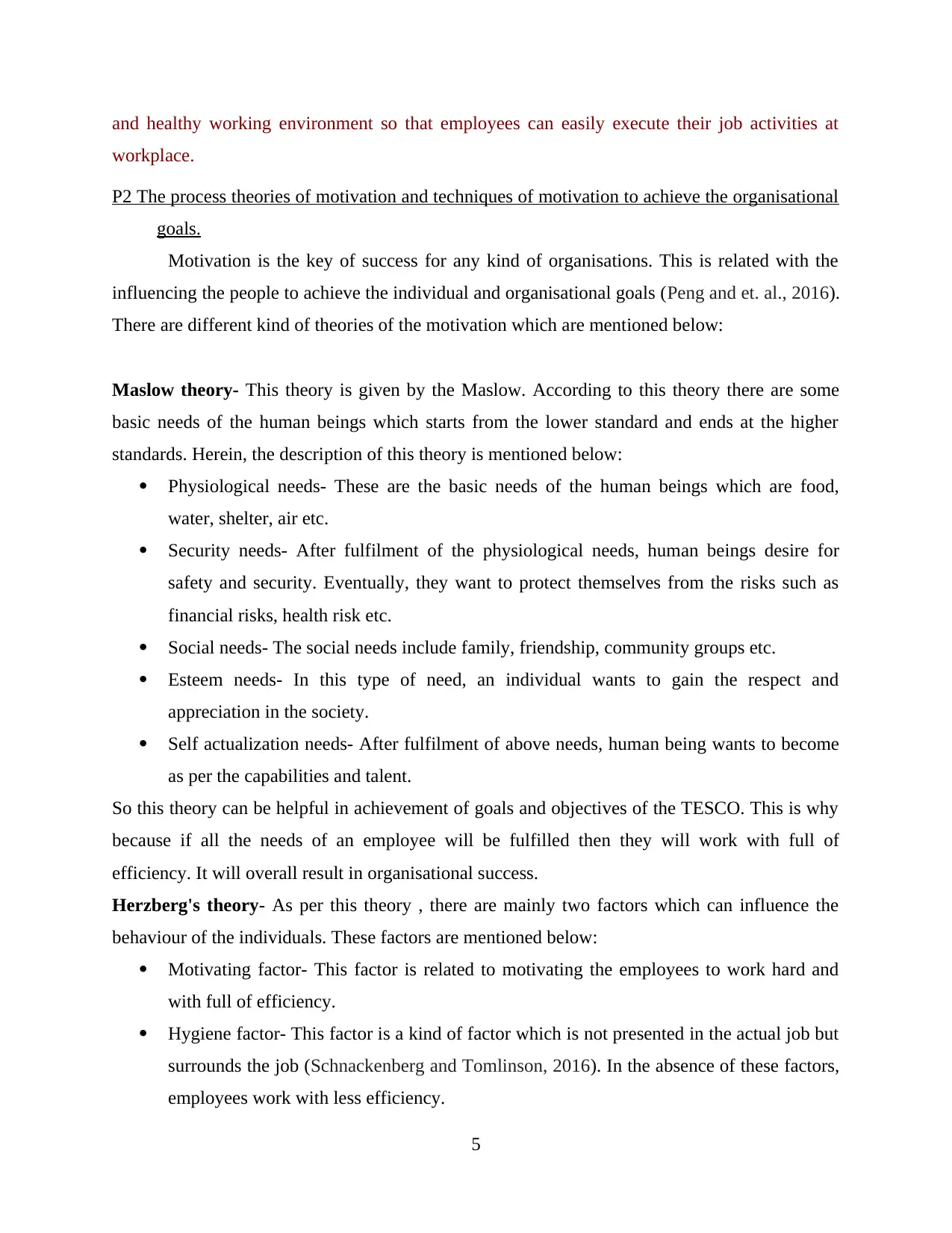
and healthy working environment so that employees can easily execute their job activities at
workplace.
P2 The process theories of motivation and techniques of motivation to achieve the organisational
goals.
Motivation is the key of success for any kind of organisations. This is related with the
influencing the people to achieve the individual and organisational goals (Peng and et. al., 2016).
There are different kind of theories of the motivation which are mentioned below:
Maslow theory- This theory is given by the Maslow. According to this theory there are some
basic needs of the human beings which starts from the lower standard and ends at the higher
standards. Herein, the description of this theory is mentioned below:
Physiological needs- These are the basic needs of the human beings which are food,
water, shelter, air etc.
Security needs- After fulfilment of the physiological needs, human beings desire for
safety and security. Eventually, they want to protect themselves from the risks such as
financial risks, health risk etc.
Social needs- The social needs include family, friendship, community groups etc.
Esteem needs- In this type of need, an individual wants to gain the respect and
appreciation in the society.
Self actualization needs- After fulfilment of above needs, human being wants to become
as per the capabilities and talent.
So this theory can be helpful in achievement of goals and objectives of the TESCO. This is why
because if all the needs of an employee will be fulfilled then they will work with full of
efficiency. It will overall result in organisational success.
Herzberg's theory- As per this theory , there are mainly two factors which can influence the
behaviour of the individuals. These factors are mentioned below:
Motivating factor- This factor is related to motivating the employees to work hard and
with full of efficiency.
Hygiene factor- This factor is a kind of factor which is not presented in the actual job but
surrounds the job (Schnackenberg and Tomlinson, 2016). In the absence of these factors,
employees work with less efficiency.
5
workplace.
P2 The process theories of motivation and techniques of motivation to achieve the organisational
goals.
Motivation is the key of success for any kind of organisations. This is related with the
influencing the people to achieve the individual and organisational goals (Peng and et. al., 2016).
There are different kind of theories of the motivation which are mentioned below:
Maslow theory- This theory is given by the Maslow. According to this theory there are some
basic needs of the human beings which starts from the lower standard and ends at the higher
standards. Herein, the description of this theory is mentioned below:
Physiological needs- These are the basic needs of the human beings which are food,
water, shelter, air etc.
Security needs- After fulfilment of the physiological needs, human beings desire for
safety and security. Eventually, they want to protect themselves from the risks such as
financial risks, health risk etc.
Social needs- The social needs include family, friendship, community groups etc.
Esteem needs- In this type of need, an individual wants to gain the respect and
appreciation in the society.
Self actualization needs- After fulfilment of above needs, human being wants to become
as per the capabilities and talent.
So this theory can be helpful in achievement of goals and objectives of the TESCO. This is why
because if all the needs of an employee will be fulfilled then they will work with full of
efficiency. It will overall result in organisational success.
Herzberg's theory- As per this theory , there are mainly two factors which can influence the
behaviour of the individuals. These factors are mentioned below:
Motivating factor- This factor is related to motivating the employees to work hard and
with full of efficiency.
Hygiene factor- This factor is a kind of factor which is not presented in the actual job but
surrounds the job (Schnackenberg and Tomlinson, 2016). In the absence of these factors,
employees work with less efficiency.
5
Paraphrase This Document
Need a fresh take? Get an instant paraphrase of this document with our AI Paraphraser
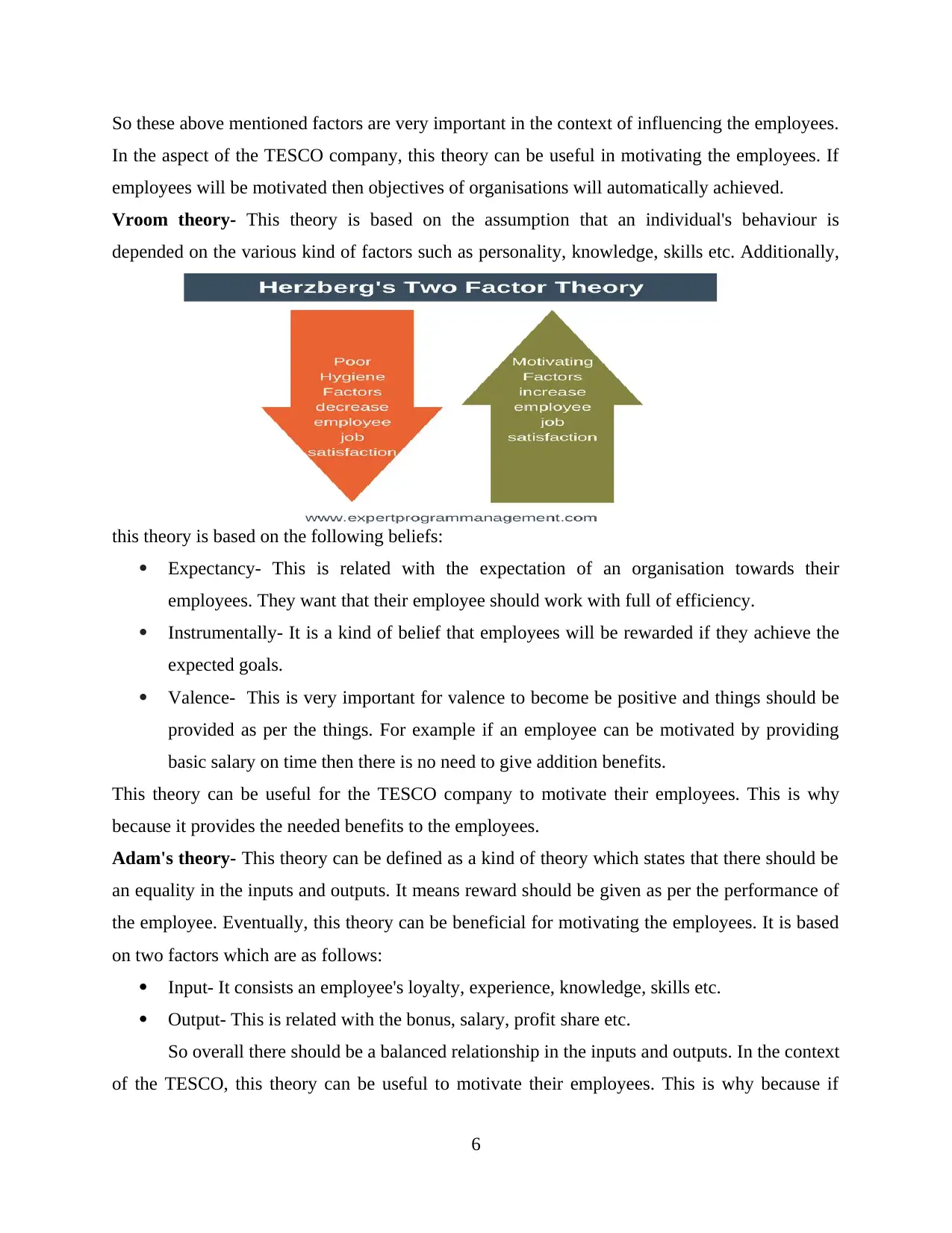
So these above mentioned factors are very important in the context of influencing the employees.
In the aspect of the TESCO company, this theory can be useful in motivating the employees. If
employees will be motivated then objectives of organisations will automatically achieved.
Vroom theory- This theory is based on the assumption that an individual's behaviour is
depended on the various kind of factors such as personality, knowledge, skills etc. Additionally,
this theory is based on the following beliefs:
Expectancy- This is related with the expectation of an organisation towards their
employees. They want that their employee should work with full of efficiency.
Instrumentally- It is a kind of belief that employees will be rewarded if they achieve the
expected goals.
Valence- This is very important for valence to become be positive and things should be
provided as per the things. For example if an employee can be motivated by providing
basic salary on time then there is no need to give addition benefits.
This theory can be useful for the TESCO company to motivate their employees. This is why
because it provides the needed benefits to the employees.
Adam's theory- This theory can be defined as a kind of theory which states that there should be
an equality in the inputs and outputs. It means reward should be given as per the performance of
the employee. Eventually, this theory can be beneficial for motivating the employees. It is based
on two factors which are as follows:
Input- It consists an employee's loyalty, experience, knowledge, skills etc.
Output- This is related with the bonus, salary, profit share etc.
So overall there should be a balanced relationship in the inputs and outputs. In the context
of the TESCO, this theory can be useful to motivate their employees. This is why because if
6
In the aspect of the TESCO company, this theory can be useful in motivating the employees. If
employees will be motivated then objectives of organisations will automatically achieved.
Vroom theory- This theory is based on the assumption that an individual's behaviour is
depended on the various kind of factors such as personality, knowledge, skills etc. Additionally,
this theory is based on the following beliefs:
Expectancy- This is related with the expectation of an organisation towards their
employees. They want that their employee should work with full of efficiency.
Instrumentally- It is a kind of belief that employees will be rewarded if they achieve the
expected goals.
Valence- This is very important for valence to become be positive and things should be
provided as per the things. For example if an employee can be motivated by providing
basic salary on time then there is no need to give addition benefits.
This theory can be useful for the TESCO company to motivate their employees. This is why
because it provides the needed benefits to the employees.
Adam's theory- This theory can be defined as a kind of theory which states that there should be
an equality in the inputs and outputs. It means reward should be given as per the performance of
the employee. Eventually, this theory can be beneficial for motivating the employees. It is based
on two factors which are as follows:
Input- It consists an employee's loyalty, experience, knowledge, skills etc.
Output- This is related with the bonus, salary, profit share etc.
So overall there should be a balanced relationship in the inputs and outputs. In the context
of the TESCO, this theory can be useful to motivate their employees. This is why because if
6

employee is rewarded on the basis of the skills and capabilities then moral will be on top which
will leads to the organisational success.
Among all these theories, the Adam smith' s theory can be beneficial for the TESCO
company. This is so because if there is equal system in the output and input then employees will
be happy and do the work with full of efficiency (Shen and Benson, 2016). Though, other
theories are also important but Adam's equity theory is suitable for the chosen organisation.
Recommendation- On the basis of above mentioned motivation theories, it is being
recommend to the TESCO company that they should try to keep motivated to all their
employees. This is why because motivation is the key of success to all the organisations. If their
employees will be motivated then it will be easy for them to achieve the goals and objectives. As
well as there are lot of theories to motivate the employees but they should implement Adam's
equity theory.
As per above mentioned theories, Maslow Hierarchical need theory is more effective for
business organization to motivate their employees. By providing motivation as per regular basis,
workers feel productive towards the allotted task activities and at the same time also put their
7
will leads to the organisational success.
Among all these theories, the Adam smith' s theory can be beneficial for the TESCO
company. This is so because if there is equal system in the output and input then employees will
be happy and do the work with full of efficiency (Shen and Benson, 2016). Though, other
theories are also important but Adam's equity theory is suitable for the chosen organisation.
Recommendation- On the basis of above mentioned motivation theories, it is being
recommend to the TESCO company that they should try to keep motivated to all their
employees. This is why because motivation is the key of success to all the organisations. If their
employees will be motivated then it will be easy for them to achieve the goals and objectives. As
well as there are lot of theories to motivate the employees but they should implement Adam's
equity theory.
As per above mentioned theories, Maslow Hierarchical need theory is more effective for
business organization to motivate their employees. By providing motivation as per regular basis,
workers feel productive towards the allotted task activities and at the same time also put their
7
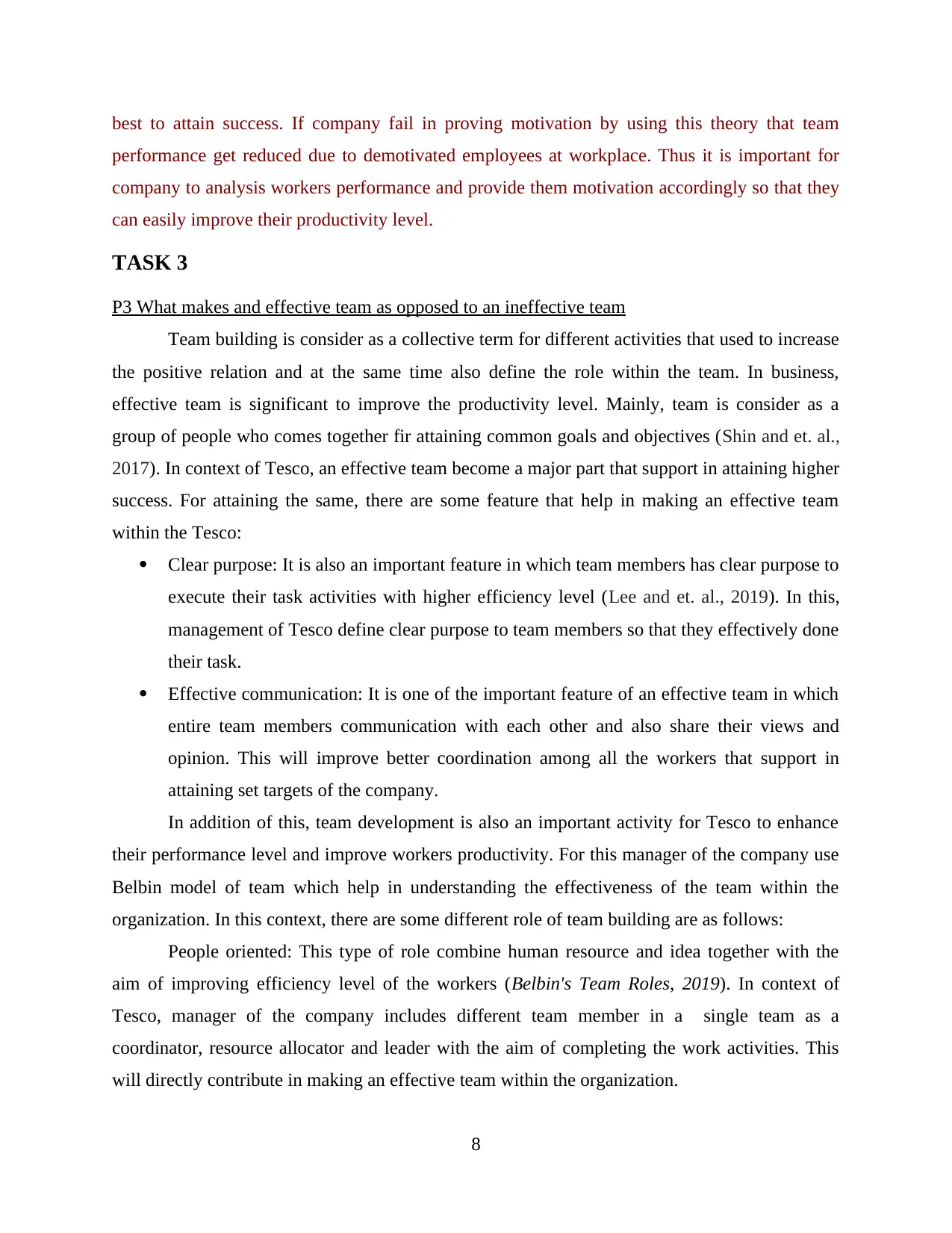
best to attain success. If company fail in proving motivation by using this theory that team
performance get reduced due to demotivated employees at workplace. Thus it is important for
company to analysis workers performance and provide them motivation accordingly so that they
can easily improve their productivity level.
TASK 3
P3 What makes and effective team as opposed to an ineffective team
Team building is consider as a collective term for different activities that used to increase
the positive relation and at the same time also define the role within the team. In business,
effective team is significant to improve the productivity level. Mainly, team is consider as a
group of people who comes together fir attaining common goals and objectives (Shin and et. al.,
2017). In context of Tesco, an effective team become a major part that support in attaining higher
success. For attaining the same, there are some feature that help in making an effective team
within the Tesco:
Clear purpose: It is also an important feature in which team members has clear purpose to
execute their task activities with higher efficiency level (Lee and et. al., 2019). In this,
management of Tesco define clear purpose to team members so that they effectively done
their task.
Effective communication: It is one of the important feature of an effective team in which
entire team members communication with each other and also share their views and
opinion. This will improve better coordination among all the workers that support in
attaining set targets of the company.
In addition of this, team development is also an important activity for Tesco to enhance
their performance level and improve workers productivity. For this manager of the company use
Belbin model of team which help in understanding the effectiveness of the team within the
organization. In this context, there are some different role of team building are as follows:
People oriented: This type of role combine human resource and idea together with the
aim of improving efficiency level of the workers (Belbin's Team Roles, 2019). In context of
Tesco, manager of the company includes different team member in a single team as a
coordinator, resource allocator and leader with the aim of completing the work activities. This
will directly contribute in making an effective team within the organization.
8
performance get reduced due to demotivated employees at workplace. Thus it is important for
company to analysis workers performance and provide them motivation accordingly so that they
can easily improve their productivity level.
TASK 3
P3 What makes and effective team as opposed to an ineffective team
Team building is consider as a collective term for different activities that used to increase
the positive relation and at the same time also define the role within the team. In business,
effective team is significant to improve the productivity level. Mainly, team is consider as a
group of people who comes together fir attaining common goals and objectives (Shin and et. al.,
2017). In context of Tesco, an effective team become a major part that support in attaining higher
success. For attaining the same, there are some feature that help in making an effective team
within the Tesco:
Clear purpose: It is also an important feature in which team members has clear purpose to
execute their task activities with higher efficiency level (Lee and et. al., 2019). In this,
management of Tesco define clear purpose to team members so that they effectively done
their task.
Effective communication: It is one of the important feature of an effective team in which
entire team members communication with each other and also share their views and
opinion. This will improve better coordination among all the workers that support in
attaining set targets of the company.
In addition of this, team development is also an important activity for Tesco to enhance
their performance level and improve workers productivity. For this manager of the company use
Belbin model of team which help in understanding the effectiveness of the team within the
organization. In this context, there are some different role of team building are as follows:
People oriented: This type of role combine human resource and idea together with the
aim of improving efficiency level of the workers (Belbin's Team Roles, 2019). In context of
Tesco, manager of the company includes different team member in a single team as a
coordinator, resource allocator and leader with the aim of completing the work activities. This
will directly contribute in making an effective team within the organization.
8
Secure Best Marks with AI Grader
Need help grading? Try our AI Grader for instant feedback on your assignments.
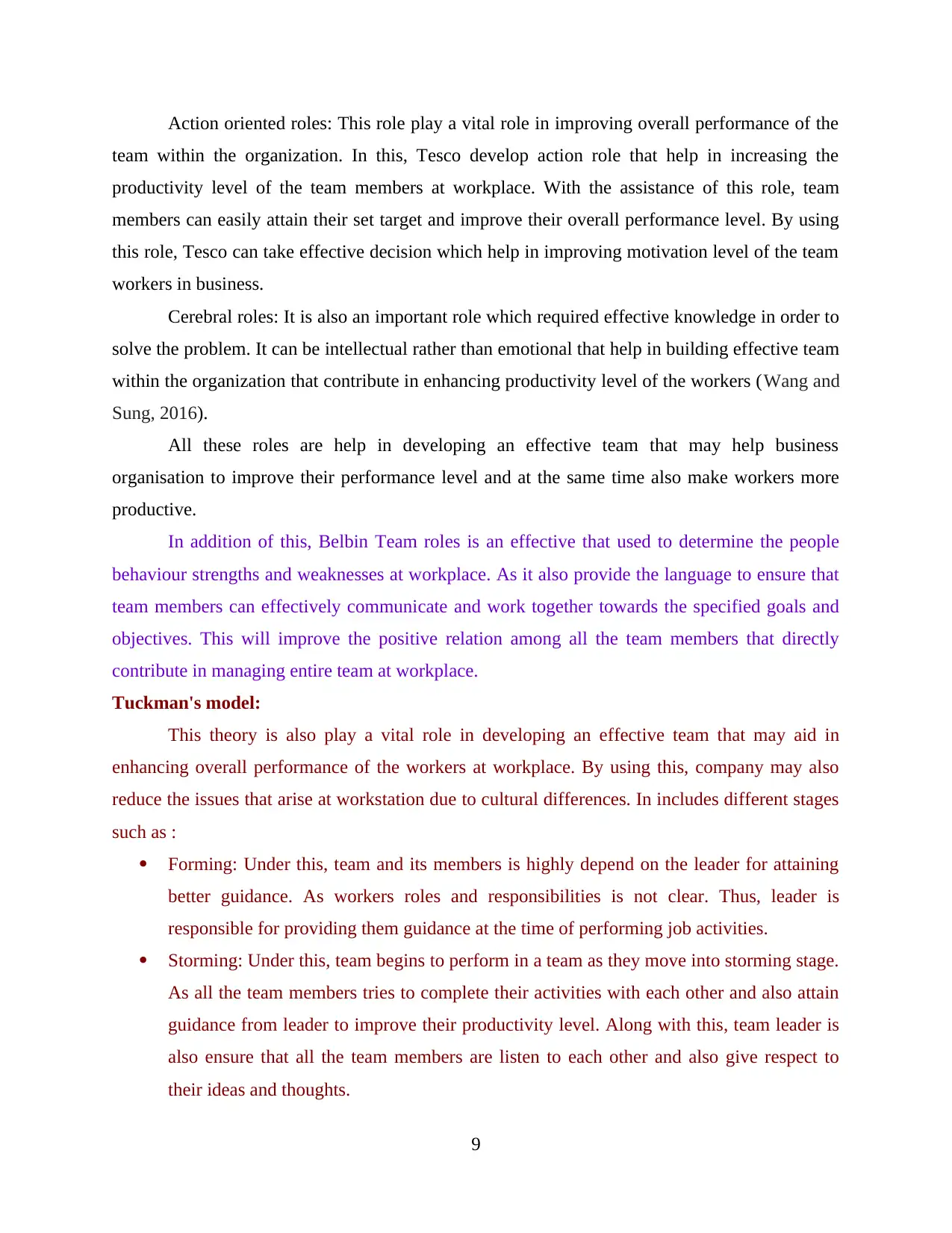
Action oriented roles: This role play a vital role in improving overall performance of the
team within the organization. In this, Tesco develop action role that help in increasing the
productivity level of the team members at workplace. With the assistance of this role, team
members can easily attain their set target and improve their overall performance level. By using
this role, Tesco can take effective decision which help in improving motivation level of the team
workers in business.
Cerebral roles: It is also an important role which required effective knowledge in order to
solve the problem. It can be intellectual rather than emotional that help in building effective team
within the organization that contribute in enhancing productivity level of the workers (Wang and
Sung, 2016).
All these roles are help in developing an effective team that may help business
organisation to improve their performance level and at the same time also make workers more
productive.
In addition of this, Belbin Team roles is an effective that used to determine the people
behaviour strengths and weaknesses at workplace. As it also provide the language to ensure that
team members can effectively communicate and work together towards the specified goals and
objectives. This will improve the positive relation among all the team members that directly
contribute in managing entire team at workplace.
Tuckman's model:
This theory is also play a vital role in developing an effective team that may aid in
enhancing overall performance of the workers at workplace. By using this, company may also
reduce the issues that arise at workstation due to cultural differences. In includes different stages
such as :
Forming: Under this, team and its members is highly depend on the leader for attaining
better guidance. As workers roles and responsibilities is not clear. Thus, leader is
responsible for providing them guidance at the time of performing job activities.
Storming: Under this, team begins to perform in a team as they move into storming stage.
As all the team members tries to complete their activities with each other and also attain
guidance from leader to improve their productivity level. Along with this, team leader is
also ensure that all the team members are listen to each other and also give respect to
their ideas and thoughts.
9
team within the organization. In this, Tesco develop action role that help in increasing the
productivity level of the team members at workplace. With the assistance of this role, team
members can easily attain their set target and improve their overall performance level. By using
this role, Tesco can take effective decision which help in improving motivation level of the team
workers in business.
Cerebral roles: It is also an important role which required effective knowledge in order to
solve the problem. It can be intellectual rather than emotional that help in building effective team
within the organization that contribute in enhancing productivity level of the workers (Wang and
Sung, 2016).
All these roles are help in developing an effective team that may help business
organisation to improve their performance level and at the same time also make workers more
productive.
In addition of this, Belbin Team roles is an effective that used to determine the people
behaviour strengths and weaknesses at workplace. As it also provide the language to ensure that
team members can effectively communicate and work together towards the specified goals and
objectives. This will improve the positive relation among all the team members that directly
contribute in managing entire team at workplace.
Tuckman's model:
This theory is also play a vital role in developing an effective team that may aid in
enhancing overall performance of the workers at workplace. By using this, company may also
reduce the issues that arise at workstation due to cultural differences. In includes different stages
such as :
Forming: Under this, team and its members is highly depend on the leader for attaining
better guidance. As workers roles and responsibilities is not clear. Thus, leader is
responsible for providing them guidance at the time of performing job activities.
Storming: Under this, team begins to perform in a team as they move into storming stage.
As all the team members tries to complete their activities with each other and also attain
guidance from leader to improve their productivity level. Along with this, team leader is
also ensure that all the team members are listen to each other and also give respect to
their ideas and thoughts.
9
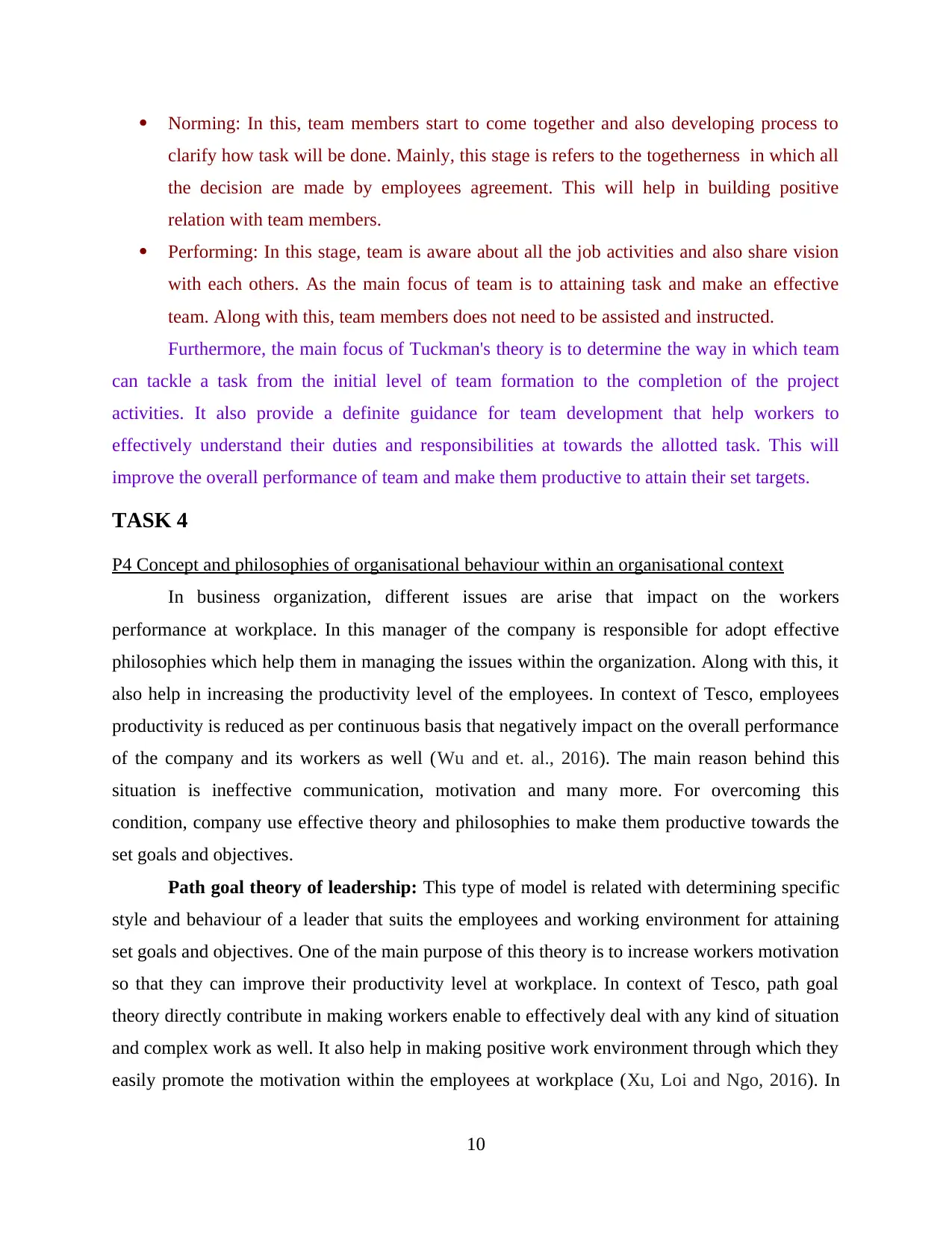
Norming: In this, team members start to come together and also developing process to
clarify how task will be done. Mainly, this stage is refers to the togetherness in which all
the decision are made by employees agreement. This will help in building positive
relation with team members.
Performing: In this stage, team is aware about all the job activities and also share vision
with each others. As the main focus of team is to attaining task and make an effective
team. Along with this, team members does not need to be assisted and instructed.
Furthermore, the main focus of Tuckman's theory is to determine the way in which team
can tackle a task from the initial level of team formation to the completion of the project
activities. It also provide a definite guidance for team development that help workers to
effectively understand their duties and responsibilities at towards the allotted task. This will
improve the overall performance of team and make them productive to attain their set targets.
TASK 4
P4 Concept and philosophies of organisational behaviour within an organisational context
In business organization, different issues are arise that impact on the workers
performance at workplace. In this manager of the company is responsible for adopt effective
philosophies which help them in managing the issues within the organization. Along with this, it
also help in increasing the productivity level of the employees. In context of Tesco, employees
productivity is reduced as per continuous basis that negatively impact on the overall performance
of the company and its workers as well (Wu and et. al., 2016). The main reason behind this
situation is ineffective communication, motivation and many more. For overcoming this
condition, company use effective theory and philosophies to make them productive towards the
set goals and objectives.
Path goal theory of leadership: This type of model is related with determining specific
style and behaviour of a leader that suits the employees and working environment for attaining
set goals and objectives. One of the main purpose of this theory is to increase workers motivation
so that they can improve their productivity level at workplace. In context of Tesco, path goal
theory directly contribute in making workers enable to effectively deal with any kind of situation
and complex work as well. It also help in making positive work environment through which they
easily promote the motivation within the employees at workplace (Xu, Loi and Ngo, 2016). In
10
clarify how task will be done. Mainly, this stage is refers to the togetherness in which all
the decision are made by employees agreement. This will help in building positive
relation with team members.
Performing: In this stage, team is aware about all the job activities and also share vision
with each others. As the main focus of team is to attaining task and make an effective
team. Along with this, team members does not need to be assisted and instructed.
Furthermore, the main focus of Tuckman's theory is to determine the way in which team
can tackle a task from the initial level of team formation to the completion of the project
activities. It also provide a definite guidance for team development that help workers to
effectively understand their duties and responsibilities at towards the allotted task. This will
improve the overall performance of team and make them productive to attain their set targets.
TASK 4
P4 Concept and philosophies of organisational behaviour within an organisational context
In business organization, different issues are arise that impact on the workers
performance at workplace. In this manager of the company is responsible for adopt effective
philosophies which help them in managing the issues within the organization. Along with this, it
also help in increasing the productivity level of the employees. In context of Tesco, employees
productivity is reduced as per continuous basis that negatively impact on the overall performance
of the company and its workers as well (Wu and et. al., 2016). The main reason behind this
situation is ineffective communication, motivation and many more. For overcoming this
condition, company use effective theory and philosophies to make them productive towards the
set goals and objectives.
Path goal theory of leadership: This type of model is related with determining specific
style and behaviour of a leader that suits the employees and working environment for attaining
set goals and objectives. One of the main purpose of this theory is to increase workers motivation
so that they can improve their productivity level at workplace. In context of Tesco, path goal
theory directly contribute in making workers enable to effectively deal with any kind of situation
and complex work as well. It also help in making positive work environment through which they
easily promote the motivation within the employees at workplace (Xu, Loi and Ngo, 2016). In
10
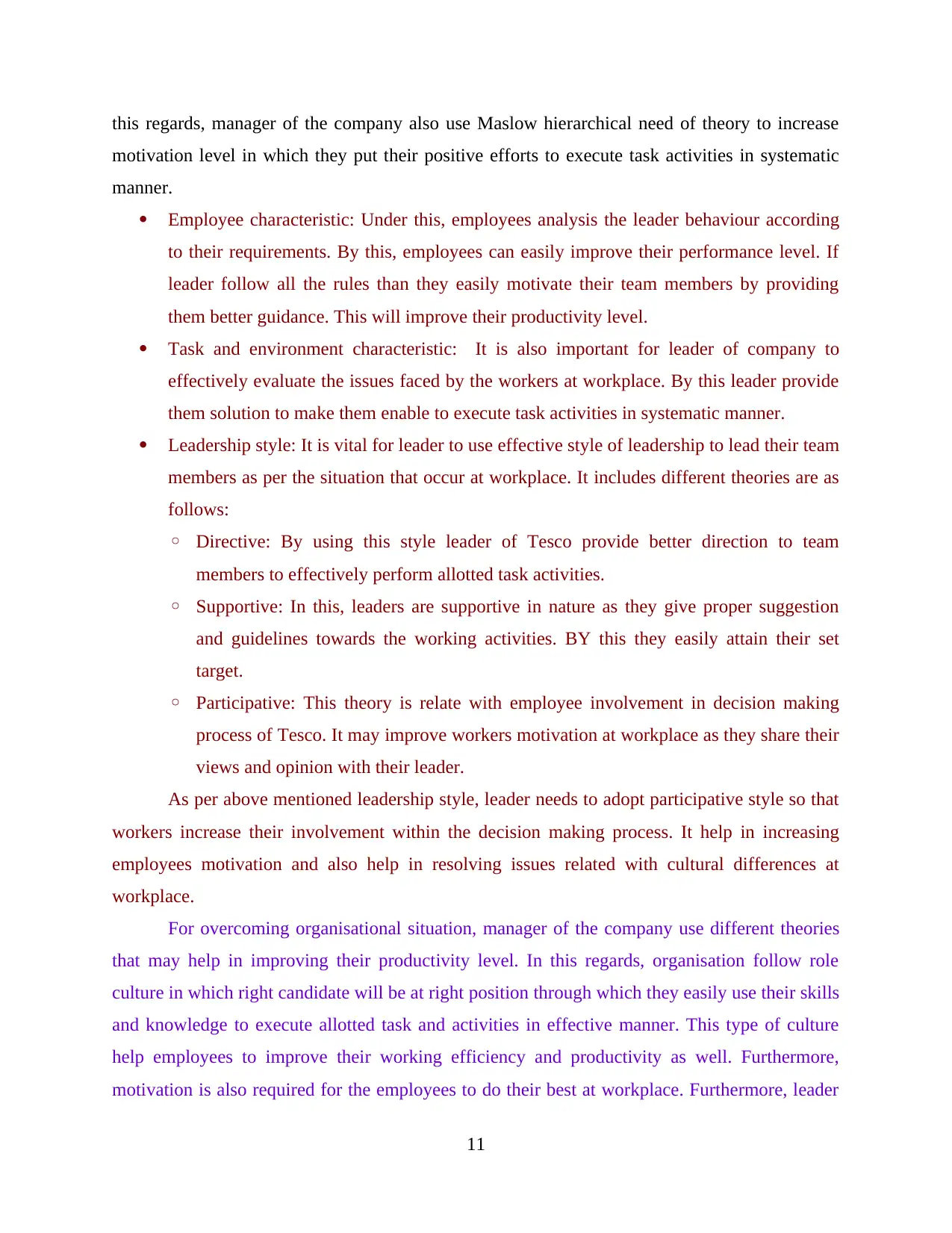
this regards, manager of the company also use Maslow hierarchical need of theory to increase
motivation level in which they put their positive efforts to execute task activities in systematic
manner.
Employee characteristic: Under this, employees analysis the leader behaviour according
to their requirements. By this, employees can easily improve their performance level. If
leader follow all the rules than they easily motivate their team members by providing
them better guidance. This will improve their productivity level.
Task and environment characteristic: It is also important for leader of company to
effectively evaluate the issues faced by the workers at workplace. By this leader provide
them solution to make them enable to execute task activities in systematic manner.
Leadership style: It is vital for leader to use effective style of leadership to lead their team
members as per the situation that occur at workplace. It includes different theories are as
follows:
◦ Directive: By using this style leader of Tesco provide better direction to team
members to effectively perform allotted task activities.
◦ Supportive: In this, leaders are supportive in nature as they give proper suggestion
and guidelines towards the working activities. BY this they easily attain their set
target.
◦ Participative: This theory is relate with employee involvement in decision making
process of Tesco. It may improve workers motivation at workplace as they share their
views and opinion with their leader.
As per above mentioned leadership style, leader needs to adopt participative style so that
workers increase their involvement within the decision making process. It help in increasing
employees motivation and also help in resolving issues related with cultural differences at
workplace.
For overcoming organisational situation, manager of the company use different theories
that may help in improving their productivity level. In this regards, organisation follow role
culture in which right candidate will be at right position through which they easily use their skills
and knowledge to execute allotted task and activities in effective manner. This type of culture
help employees to improve their working efficiency and productivity as well. Furthermore,
motivation is also required for the employees to do their best at workplace. Furthermore, leader
11
motivation level in which they put their positive efforts to execute task activities in systematic
manner.
Employee characteristic: Under this, employees analysis the leader behaviour according
to their requirements. By this, employees can easily improve their performance level. If
leader follow all the rules than they easily motivate their team members by providing
them better guidance. This will improve their productivity level.
Task and environment characteristic: It is also important for leader of company to
effectively evaluate the issues faced by the workers at workplace. By this leader provide
them solution to make them enable to execute task activities in systematic manner.
Leadership style: It is vital for leader to use effective style of leadership to lead their team
members as per the situation that occur at workplace. It includes different theories are as
follows:
◦ Directive: By using this style leader of Tesco provide better direction to team
members to effectively perform allotted task activities.
◦ Supportive: In this, leaders are supportive in nature as they give proper suggestion
and guidelines towards the working activities. BY this they easily attain their set
target.
◦ Participative: This theory is relate with employee involvement in decision making
process of Tesco. It may improve workers motivation at workplace as they share their
views and opinion with their leader.
As per above mentioned leadership style, leader needs to adopt participative style so that
workers increase their involvement within the decision making process. It help in increasing
employees motivation and also help in resolving issues related with cultural differences at
workplace.
For overcoming organisational situation, manager of the company use different theories
that may help in improving their productivity level. In this regards, organisation follow role
culture in which right candidate will be at right position through which they easily use their skills
and knowledge to execute allotted task and activities in effective manner. This type of culture
help employees to improve their working efficiency and productivity as well. Furthermore,
motivation is also required for the employees to do their best at workplace. Furthermore, leader
11
Paraphrase This Document
Need a fresh take? Get an instant paraphrase of this document with our AI Paraphraser

of company also use participative leadership style to encourage them to take participant in
decision making activities (Yahaya and Ebrahim, 2016). It may help in improving their
efficiency and motivation level. For attaining the same, manager use Maslow need hierarchical
theory in which they give them rewards, monetary benefits, appreciation and many more to make
them motivate towards the set goals. After motivating the workers, team building is also
important for them to make them productive. In this leader of the company use Tuckman's theory
to building the team. By using this, manager provide them guidance to effectively perform their
activities at workplace and also keep positive relation with other team members.
All these philosophies are effective for improving the employees productivity by
providing them better motivation and guidance at workplace. This is because manager of the
company focus on the workers performance that how they perform their working activities. IF
there are any requirement to improve then they guide them and improve their performance as
well. With the help of this Tesco can easily handle the situation and also make workers more
productive within the organization.
CONCLUSION
From the above mentioned report it has been concluded that, organizational behaviour
play a vital role in influencing employees performance at workplace. If working environment
and behaviour of organisation is not effective then workers get demotivated towards working
activities. This will negatively impact on the overall performance of the company and its workers
as well. In this context, motivational theory such as Maslow need hierarchy theory is also an
effective that help in motivating workers so that they perform their best to attain set target.
Furthermore, Belbin model of team is also an effective theory of team development which
support in making workers more productive. It may help in attaining all the common goals and
objectives in appropriate time frame.
12
decision making activities (Yahaya and Ebrahim, 2016). It may help in improving their
efficiency and motivation level. For attaining the same, manager use Maslow need hierarchical
theory in which they give them rewards, monetary benefits, appreciation and many more to make
them motivate towards the set goals. After motivating the workers, team building is also
important for them to make them productive. In this leader of the company use Tuckman's theory
to building the team. By using this, manager provide them guidance to effectively perform their
activities at workplace and also keep positive relation with other team members.
All these philosophies are effective for improving the employees productivity by
providing them better motivation and guidance at workplace. This is because manager of the
company focus on the workers performance that how they perform their working activities. IF
there are any requirement to improve then they guide them and improve their performance as
well. With the help of this Tesco can easily handle the situation and also make workers more
productive within the organization.
CONCLUSION
From the above mentioned report it has been concluded that, organizational behaviour
play a vital role in influencing employees performance at workplace. If working environment
and behaviour of organisation is not effective then workers get demotivated towards working
activities. This will negatively impact on the overall performance of the company and its workers
as well. In this context, motivational theory such as Maslow need hierarchy theory is also an
effective that help in motivating workers so that they perform their best to attain set target.
Furthermore, Belbin model of team is also an effective theory of team development which
support in making workers more productive. It may help in attaining all the common goals and
objectives in appropriate time frame.
12
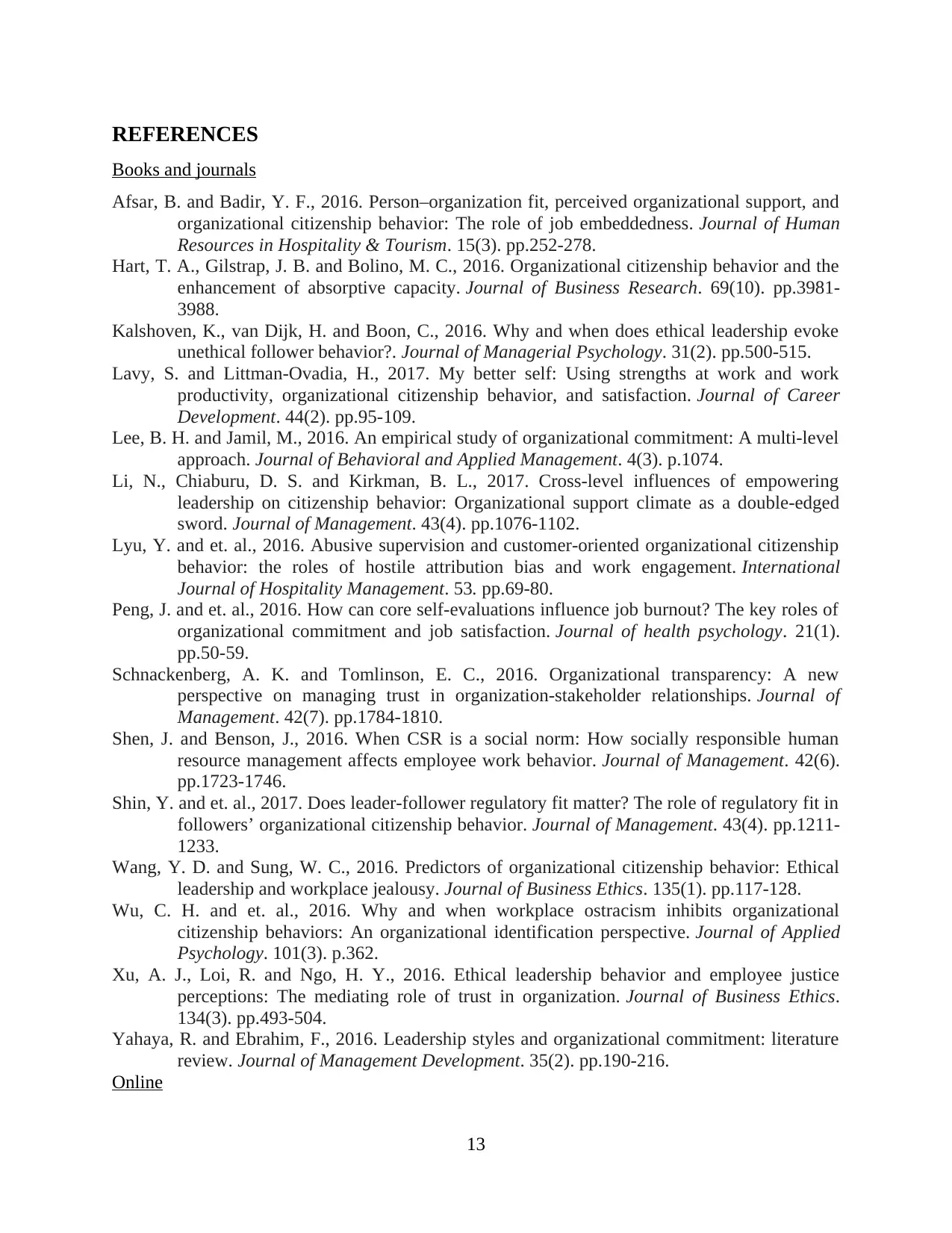
REFERENCES
Books and journals
Afsar, B. and Badir, Y. F., 2016. Person–organization fit, perceived organizational support, and
organizational citizenship behavior: The role of job embeddedness. Journal of Human
Resources in Hospitality & Tourism. 15(3). pp.252-278.
Hart, T. A., Gilstrap, J. B. and Bolino, M. C., 2016. Organizational citizenship behavior and the
enhancement of absorptive capacity. Journal of Business Research. 69(10). pp.3981-
3988.
Kalshoven, K., van Dijk, H. and Boon, C., 2016. Why and when does ethical leadership evoke
unethical follower behavior?. Journal of Managerial Psychology. 31(2). pp.500-515.
Lavy, S. and Littman-Ovadia, H., 2017. My better self: Using strengths at work and work
productivity, organizational citizenship behavior, and satisfaction. Journal of Career
Development. 44(2). pp.95-109.
Lee, B. H. and Jamil, M., 2016. An empirical study of organizational commitment: A multi-level
approach. Journal of Behavioral and Applied Management. 4(3). p.1074.
Li, N., Chiaburu, D. S. and Kirkman, B. L., 2017. Cross-level influences of empowering
leadership on citizenship behavior: Organizational support climate as a double-edged
sword. Journal of Management. 43(4). pp.1076-1102.
Lyu, Y. and et. al., 2016. Abusive supervision and customer-oriented organizational citizenship
behavior: the roles of hostile attribution bias and work engagement. International
Journal of Hospitality Management. 53. pp.69-80.
Peng, J. and et. al., 2016. How can core self-evaluations influence job burnout? The key roles of
organizational commitment and job satisfaction. Journal of health psychology. 21(1).
pp.50-59.
Schnackenberg, A. K. and Tomlinson, E. C., 2016. Organizational transparency: A new
perspective on managing trust in organization-stakeholder relationships. Journal of
Management. 42(7). pp.1784-1810.
Shen, J. and Benson, J., 2016. When CSR is a social norm: How socially responsible human
resource management affects employee work behavior. Journal of Management. 42(6).
pp.1723-1746.
Shin, Y. and et. al., 2017. Does leader-follower regulatory fit matter? The role of regulatory fit in
followers’ organizational citizenship behavior. Journal of Management. 43(4). pp.1211-
1233.
Wang, Y. D. and Sung, W. C., 2016. Predictors of organizational citizenship behavior: Ethical
leadership and workplace jealousy. Journal of Business Ethics. 135(1). pp.117-128.
Wu, C. H. and et. al., 2016. Why and when workplace ostracism inhibits organizational
citizenship behaviors: An organizational identification perspective. Journal of Applied
Psychology. 101(3). p.362.
Xu, A. J., Loi, R. and Ngo, H. Y., 2016. Ethical leadership behavior and employee justice
perceptions: The mediating role of trust in organization. Journal of Business Ethics.
134(3). pp.493-504.
Yahaya, R. and Ebrahim, F., 2016. Leadership styles and organizational commitment: literature
review. Journal of Management Development. 35(2). pp.190-216.
Online
13
Books and journals
Afsar, B. and Badir, Y. F., 2016. Person–organization fit, perceived organizational support, and
organizational citizenship behavior: The role of job embeddedness. Journal of Human
Resources in Hospitality & Tourism. 15(3). pp.252-278.
Hart, T. A., Gilstrap, J. B. and Bolino, M. C., 2016. Organizational citizenship behavior and the
enhancement of absorptive capacity. Journal of Business Research. 69(10). pp.3981-
3988.
Kalshoven, K., van Dijk, H. and Boon, C., 2016. Why and when does ethical leadership evoke
unethical follower behavior?. Journal of Managerial Psychology. 31(2). pp.500-515.
Lavy, S. and Littman-Ovadia, H., 2017. My better self: Using strengths at work and work
productivity, organizational citizenship behavior, and satisfaction. Journal of Career
Development. 44(2). pp.95-109.
Lee, B. H. and Jamil, M., 2016. An empirical study of organizational commitment: A multi-level
approach. Journal of Behavioral and Applied Management. 4(3). p.1074.
Li, N., Chiaburu, D. S. and Kirkman, B. L., 2017. Cross-level influences of empowering
leadership on citizenship behavior: Organizational support climate as a double-edged
sword. Journal of Management. 43(4). pp.1076-1102.
Lyu, Y. and et. al., 2016. Abusive supervision and customer-oriented organizational citizenship
behavior: the roles of hostile attribution bias and work engagement. International
Journal of Hospitality Management. 53. pp.69-80.
Peng, J. and et. al., 2016. How can core self-evaluations influence job burnout? The key roles of
organizational commitment and job satisfaction. Journal of health psychology. 21(1).
pp.50-59.
Schnackenberg, A. K. and Tomlinson, E. C., 2016. Organizational transparency: A new
perspective on managing trust in organization-stakeholder relationships. Journal of
Management. 42(7). pp.1784-1810.
Shen, J. and Benson, J., 2016. When CSR is a social norm: How socially responsible human
resource management affects employee work behavior. Journal of Management. 42(6).
pp.1723-1746.
Shin, Y. and et. al., 2017. Does leader-follower regulatory fit matter? The role of regulatory fit in
followers’ organizational citizenship behavior. Journal of Management. 43(4). pp.1211-
1233.
Wang, Y. D. and Sung, W. C., 2016. Predictors of organizational citizenship behavior: Ethical
leadership and workplace jealousy. Journal of Business Ethics. 135(1). pp.117-128.
Wu, C. H. and et. al., 2016. Why and when workplace ostracism inhibits organizational
citizenship behaviors: An organizational identification perspective. Journal of Applied
Psychology. 101(3). p.362.
Xu, A. J., Loi, R. and Ngo, H. Y., 2016. Ethical leadership behavior and employee justice
perceptions: The mediating role of trust in organization. Journal of Business Ethics.
134(3). pp.493-504.
Yahaya, R. and Ebrahim, F., 2016. Leadership styles and organizational commitment: literature
review. Journal of Management Development. 35(2). pp.190-216.
Online
13
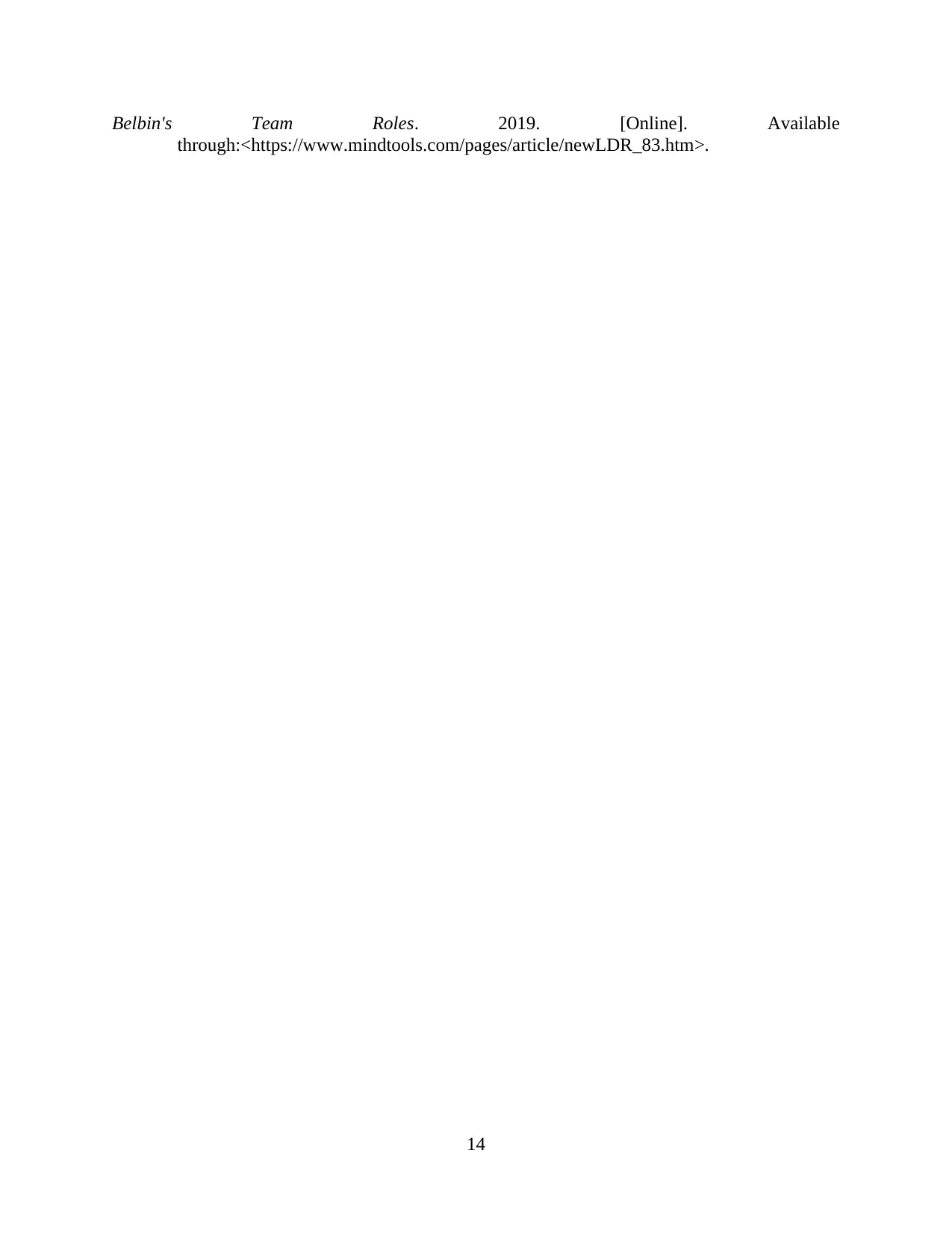
Belbin's Team Roles. 2019. [Online]. Available
through:<https://www.mindtools.com/pages/article/newLDR_83.htm>.
14
through:<https://www.mindtools.com/pages/article/newLDR_83.htm>.
14
1 out of 16
Related Documents
Your All-in-One AI-Powered Toolkit for Academic Success.
+13062052269
info@desklib.com
Available 24*7 on WhatsApp / Email
![[object Object]](/_next/static/media/star-bottom.7253800d.svg)
Unlock your academic potential
© 2024 | Zucol Services PVT LTD | All rights reserved.




